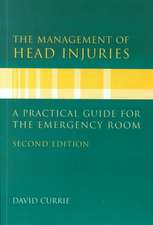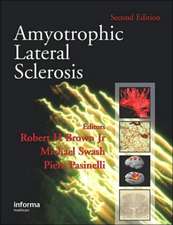First Exposure to Neurology
Autor Howard Kirshneren Limba Engleză Paperback – 16 mar 2007
The Ultimate Neurology Clerkship Companion
Everything you need for your rotation in neurology is right at your fingertips in this portable, hands-on guide. With its streamlined coverage of diagnostic skills, symptom complexes, specific diseases, plus “Don't Miss Diagnoses,” FIRST EXPOSURE TO NEUROLOGY accelerates your mastery of the core competencies of the Neurology clerkship.
The ideal databank and toolset for your rotation
FIRST EXPOSURE TO NEUROLOGY enhances your rotation with:
Preț: 321.30 lei
Preț vechi: 459.09 lei
-30% Nou
Puncte Express: 482
Preț estimativ în valută:
61.48€ • 64.35$ • 51.17£
61.48€ • 64.35$ • 51.17£
Carte tipărită la comandă
Livrare economică 28 martie-08 aprilie
Preluare comenzi: 021 569.72.76
Specificații
ISBN-13: 9780071458191
ISBN-10: 0071458190
Pagini: 320
Dimensiuni: 150 x 226 x 17 mm
Greutate: 0.52 kg
Editura: McGraw Hill Education
Colecția McGraw Hill / Medical
Locul publicării:United States
ISBN-10: 0071458190
Pagini: 320
Dimensiuni: 150 x 226 x 17 mm
Greutate: 0.52 kg
Editura: McGraw Hill Education
Colecția McGraw Hill / Medical
Locul publicării:United States
Cuprins
Section I. Approach to the neurological patient
Chapter 1. The Neurological Examination
a. How to take a neurological history
b. How to perform a comprehensive neurological examination
c. How to perform a screening neurological examination
d. How to examine an obtunded or comatose patient
e. How to interpret findings of the neurological examination
f. An approach to differential diagnosis
Chapter 2. Localization of neurological lesions
a.Cerebral hemisphere lesions
b.Posterior fossa lesions
c.Spinal cord lesions
d.Nerve root/plexus lesions
e.Peripheral nerve lesions
f.Muscle disorders
Section II. Neurological symptom complexes
Chapter 3. Focal weakness
Chapter 4. Diffuse weaknessChapter 5. Clumsiness and ataxia
Chapter 6. Involuntary movementsChapter 7. Gait disturbance
Chapter 8. Bowel, bladder, and sexual dysfunctionChapter 9. Dizziness and vertigo
Chapter 10. Vision lossChapter 11. Diplopia
Chapter 12. DysarthriaChapter 13. Dysphagia
Chapter 14. Acute mental status changes, deliriumChapter 15. Dementia
Chapter 16. AphasiaChapter 17. Headache
Chapter 18. Focal pain syndromesi.Facial painii.Neck pain
iii.Low back pain
iv.Neuropathic (dysesthetic) pain
Chapter 19. Numbness or paresthesias
Chapter 20. Transient or episodic focal symptomsChapter 21. Transient or episodic alteration of consciousness
Chapter 22. Sleep disordersChapter 23. Developmental disorders
Section IV. Approach to specific neurological diseases
Chapter 24. Neurological emergencies
a. Increased intracranial pressure
b.Encephalopathy/delirium
c.Subarachnoid hemorrhage
d.Meningitis, encephalitis
e.Status epilepticus
f.Acute stroke and cerebral hemorrhage
g.Spinal cord or cauda equina syndromes
h.Traumatic brain injury
i.Acute respiratory distress secondary to neuromuscular disease
j.Temporal arteritis










